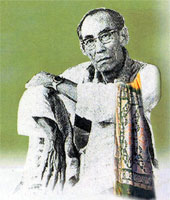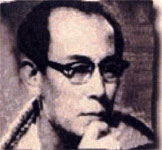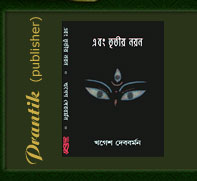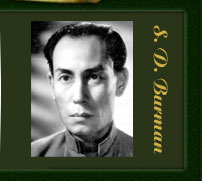 |
|
| |
| The Musical World of S. D. Burman - Khagesh Dev Burman |
 Sachin Dev Burman, popularly known as Sachin Karta in Bengal and S. D. Burman or S. D. in Bollywood in a word is 'impossible'. Impossible to imitate, impossible to bye-pass. His enchanted, animated tune mesmerizes you into a trance that leads to tranquility and bliss. As a singer his thin but powerful accented voice was often used as a bardic commentary. He played the part of Vivek (Conscience) of Bengali Jatra in the Hindi film songs e.g. 'Ore Majhi, mere sajan hai uspar' in Bandini, 'Wahan Kaun hai tera musafir' in Guide. As a composer and singer his tunes are no doubt, very simple but difficult to imitate, reason being his constant endeavour for years to create a style of his own. Whoever may be the music director or composer when S. D. Burman sings a song composed by others, it becomes S. D. Burman's because of his unique style which he could develop after prolong practice of different musical forms such as, classical, semi-classical, modern and folk music. All songs sung by him whether composed by him or others bear his own stamp. He created songs that bore the authority of his inimitable genius, abounding in variety yet retaining the distinction of his style. Drawing from the vast store of folk music forms and from the classical teachings as the mood called for, he produced what is known as Sachin Dev Burman's music which is at once round, vibrant and unorthodox both in form and substance. This is why the unique features of the musical world of S. D. Burman demand a different perspective view for the connoisseurs of music. Sachin Dev Burman, popularly known as Sachin Karta in Bengal and S. D. Burman or S. D. in Bollywood in a word is 'impossible'. Impossible to imitate, impossible to bye-pass. His enchanted, animated tune mesmerizes you into a trance that leads to tranquility and bliss. As a singer his thin but powerful accented voice was often used as a bardic commentary. He played the part of Vivek (Conscience) of Bengali Jatra in the Hindi film songs e.g. 'Ore Majhi, mere sajan hai uspar' in Bandini, 'Wahan Kaun hai tera musafir' in Guide. As a composer and singer his tunes are no doubt, very simple but difficult to imitate, reason being his constant endeavour for years to create a style of his own. Whoever may be the music director or composer when S. D. Burman sings a song composed by others, it becomes S. D. Burman's because of his unique style which he could develop after prolong practice of different musical forms such as, classical, semi-classical, modern and folk music. All songs sung by him whether composed by him or others bear his own stamp. He created songs that bore the authority of his inimitable genius, abounding in variety yet retaining the distinction of his style. Drawing from the vast store of folk music forms and from the classical teachings as the mood called for, he produced what is known as Sachin Dev Burman's music which is at once round, vibrant and unorthodox both in form and substance. This is why the unique features of the musical world of S. D. Burman demand a different perspective view for the connoisseurs of music.
The Back Ground -
Born in Comilla (now Bangladesh) on Oct. 1, 1906 which was a small town in Chakla Roshanabad (under British rule Zemindary of Maharaja of Tripura), Sachin Dev Burman was a scion of the princely family of Tripura. Nabadwip Chandra, father of S. D. Burman was the direct heir to the kingdom of Tripura when intrigue of the palace politics forced him to stay outside Tripura as a banished Prince. As ill luck would have it, Uncle Birchandra Manikya became the king by a Robkari (Order) issued by his (Nabadwip) father Ishan Chandra Manikya a day before his death. It was a boon in disguise. We could not have got S. D. Burman as a titan amongst composers & singer of songs if that unnatural event had not been taken place. Had he been born in Agartala (Capital of Tripura), possibly we would have got an expert in classical music known within the ambit of Tripura but versatile, vibrant singer, composer of variety of enchanted music would've been lost in oblivion.
 The birth of Sachin at Comilla made all the difference. Sachin was the youngest of Nabadwip Chandra's five sons & two daughters. An adept in playing sitar apart from excelling in drupad singing and sculpting, it was Nabadwip Chandra and his fourth son Lt.Col. Kiran Kumar who gave Sachin the inspiration to delve in music. Mother Nirupama Devi hailed from Royal family of Manipur, famous for Manipuri Gharana of music and dance. Elder sister Telottama Devi was also an expert in classical music. Sachin was influenced by his dear brother Kiran Kumar about whom he wrote—'Temperamentally he was obsessed in fine arts. He used to sing with tune and tempo giving stress to Khatki and Murki. He was a great painter and sculptor?' Sachin's childhood gurus were two helping hands, the old Madhav who would sing passages from Ramay ana humming the same tune without any mastery or skill and the young Anwar, his sparring partner in angling who would sing Bhatiali with dotara. In his autobiography S. D. Burman wrote - 'I used to forget memorizing grammer when at night Anwar with dotara started singing Bhatiali song. Next day inspite of being rebuked by the school teacher, at night again instead of mastering grammer and doing arithmetics, I used to sit close beside Anwar and get lost in his music?' The birth of Sachin at Comilla made all the difference. Sachin was the youngest of Nabadwip Chandra's five sons & two daughters. An adept in playing sitar apart from excelling in drupad singing and sculpting, it was Nabadwip Chandra and his fourth son Lt.Col. Kiran Kumar who gave Sachin the inspiration to delve in music. Mother Nirupama Devi hailed from Royal family of Manipur, famous for Manipuri Gharana of music and dance. Elder sister Telottama Devi was also an expert in classical music. Sachin was influenced by his dear brother Kiran Kumar about whom he wrote—'Temperamentally he was obsessed in fine arts. He used to sing with tune and tempo giving stress to Khatki and Murki. He was a great painter and sculptor?' Sachin's childhood gurus were two helping hands, the old Madhav who would sing passages from Ramay ana humming the same tune without any mastery or skill and the young Anwar, his sparring partner in angling who would sing Bhatiali with dotara. In his autobiography S. D. Burman wrote - 'I used to forget memorizing grammer when at night Anwar with dotara started singing Bhatiali song. Next day inspite of being rebuked by the school teacher, at night again instead of mastering grammer and doing arithmetics, I used to sit close beside Anwar and get lost in his music?'
Nabadwip Chandra Bahadur after having forty years of exiled life came to Agartala as Rajmantri in the year 1909 at the request of his nephew Maharaj Birendra Kishore Manikya. Sachin was admitted in 'Kumar Boarding' meant for princes. Nabadwip Chandra noticed that in 'Kumar Boarding' Princes were treated with reverence and not punished for lapses. Immediately Nabadwip Chandra got Sachin out of 'Kumar Boarding' and admitted him in zila school at Comilla. Fate played a vital role. In Agartala Sachin was a prince who could not behave like a common man. The naughty, vibrant, mischievious Sachin of Comilla who in bare foot used to sail on boat in the river Gumti, in creek and explore the marshy land, the rolling hillocks and jungles of East Bengal and Tripura from where he gained his formidable knowledge and rich reportoire of the folk of that region strangely changed his colour the moment he stepped in Agartala. The transformation from a mischievious boy to a grave prince with all etiquette intact was unique to observe although in the words of S. D. Burman 'my father had no pride and prejudices', but the quotation was limited to Comilla only where Nabadwip Chandra allowed his son to behave in a normal way. Nabadwip Chandra also wanted Sachin to behave like a prince at Agartala. The plalace atmosphere was such that he could not do otherwise.
That is why I said, Comilla in true sense had given birth to Sachin Dev Burman as an exponent of folk-music. As a man possessed he used to roam all over East Bengal and spent nights together in the courtyard of the thatched house of the Boatmen, Baishnavs, Fakirs and farmers etc and gathered like a bee the honey hidden in the treasure of folk-lore. There was no electricity in the villages at that point of time and therefore, the function was to be held under moonlight or Kupi (Open version of hurricane-lamp). The singers used to sit in a round form with pair of Cymbals (Kartal), Khol and flute etc and sing at the top of the voice (Saptam Sur) piercing the silence of midnight. If he had not been bom at Comilla and acquired basket full of gems of folk lore who could have with ektara in hand chanted— 'Rongila, Rongila Rongila re, Amara chardiya re bandhu kai gela re' (Oh my dear colourful friend, where have you gone away leaving me behind) or that of a boatman tearing your very soul with his call of 'Ore Majhi, mera sajan hai uspar' or that much more haunting tune from old gold which portrays Indian people's rustic philosophy of illusion and reality 'Suno mere bandhu re'?
Let me now depict the cultural environs of Comilla at that point of time which played a vital part in the career of S. D. Burman and contributed to the growth of the seed of music inside him to its saturation point. 'Surlok' of Thakur Para, 'Sabuj Sangha'-a dramatic group of Kandirpara, 'The great vernal theatre party', 'young men's club' etc were engaged in variety of cultural activities and persons behind them were no less famous than Nazrul, music composer sursagar Himangshu Dutta, lyricist Ajoy Bhattacharya and Mohini Choudhury, singer Shaila Bala Dam, Dhrupad singer Souren Das and Sudhin Das, film director Sushil Majumder et^not to speak of C/ Sachin himself. The environment inside and outside home had tremendous influence in developing the talents of S. D. Burman as a singer and great composer of music. |
| |
The Musical World -
After completing B. A. from Comilla Victoria College (1924) he left for Kolkata for his MA. in English. But music was his destiny. He chose the legendry Krishna Chandra Dey (Blind Singer) Manna Dey's uncle as his Guru.
He could give shape to Krishna Chandra's classical knowledge of 'laya' and expertness in the baul of Dadra as his own by assimilating them thoroughly. His next Guru was Ustad Badal Khan. Krishna Chandra's loud and grave manly voice and Badal Khan's expanse of sweet note had greatly influenced his thinking process in the field of music. Next guru was Ustad Bhishmadev Chattopadhyay, known for his proficiency in classical music. He also assimilated Bhishmadev's novel way of creation of classical music and synthesised it with the longing of flok-music. From Shyamlal Khetri he learnt Benarasi Tumri and the process of making 'baul'.
Time was overdue for his memorable appearance. But what a shock! H. M. V. rejected him outright in audition. Unthinkable but it happened. He was told that his nasal tune was not suitable for recording. Gravely hurt S. D. was completely taken a back and disappointed. Disappointment however, did not last sine dai and the inevitable happened. Hindustan Musical Products invited him immediately after and he cut his first disc as a singer cum composer in 1932 which had a semi-classical number on one side—' Aai pathe aaj esho priya' (come this way today my beloved) and 'Dakle kokil roj bihane' (Cuckoo calls each morning) - a folk based on the other was a super hit. A 'Star' was born to give a new shape to the art of singing and composing, so much so that he surpassed his contemporaries to become the highest paid singer when Bombay finally roped him in 1944.
After the stupendous success of his first disc what a fall? It was a painful experience. His first song in film Yahudi Ki Ladki as an actor-singer was scraped and replaced at the last moment by another stalwart of yester years Pahadi Sanyal. Life as a singer and composer of music was not a cake-walk for him in Kolkata. He had to face wild criticism. All the stalwarts of filmdom & music were very much known to him but none had extended helping hand or cooperation. His firs film composition was in 1935 for 'Sajer Pradip'. Prior to his departure for Bombay in 1944, fourteen films were released in Bengali under his music direction. Howerver, success as a composer of film songs did not quite come because of his style of music. When in a film he himself sings, the songs become a hit e. g. 'Ore sujan naiya', 'Nishithe jaio phulabane' (Sajer Pradip), 'Tumi ni amar bandhu', 'Bandhu bansi dao more' (Sudurer Priya), 'Ore bandhu re, maner katha', 'Saje nawal kishore chader (Rajgi), 'Bansuriare kothai shikhecho (Rajkumarer Nirvasan). The then playback singers of Bengal could not reproduce the tunes composed by him because his compositions had a unique style of its own not imitable by the singers. His musical life in Kolkata as a composer was therefore, not a success at all. But as a singer his fans ranged from musical giants to the common men of the pavements of Bengal. That is why although he left for Bombay his soul was omnipresent in Kolkata. He could never forget Kolkata. Every year, even after going to Bombay till his death he presented Bengali unforgettable, immemorable songs to the connoisseurs of music of Bengal.
To understand musician S. D. Burman, the basic features of his music are to be high lighted. |
| |
1. Tune first, lyrics later -
S. D. Burman was the first music director who introduced the idea of tune first, the lyrics later. It was just reverse before. On the basis of song sequence he had many alternative tunes thus giving the producers a wide choice. This shows that he used to play with his tunes all the while and store them for future purposes. It also further proves that he was much ahead of his time.
2. Change of words in original lyrics -
He used to segregate the words in a sentence intermingling them in such a way that the inner meaning and melody of the song subsisted in the hearts of the listeners. 'Ami' a magic word prevails in the tune of the song 'Ami patha cheya roba'. He sang it like this 'Patha cheye roba / Ami/ patha cheya roba/ Pada dhuli haba /Ami pada dhuli haba/ Roba / Ami patha cheye roba.' 'Hai' is the word very dear to him. The word 'Hai' might not exist in the original lyrics but to emphasize grief, he inevitably would use extra 'Hai' to magnify melancholy e. g. 'Age jadhi jantam banshi chaida jaba more (Hai Hai) / Chaida jaba more/ Banshi amar maran bachan (Hai, Hai) Banshi amar pran'. He did the same thing in Hindi films also in almost all lyrics.
3. Stress in the letter of the alphabet -
One may say what is new about it, every singer has to give stress in the word or letter of the lyric to make it viable for vibration. True, but S. D. Burman went out of the prevalent practice and gave stress to the word or letter which was uncommon e.g. in 'pholon ke rangse' or 'Tadbeer sey bigrhee whui Taqdeer banaley', stress was given not to a particular letter but to the full stanza of the 'mukhra' of the song. In 'Bhulaye amay dodin' ordinary singer would have given stress in the letter 'Bhu' Whereas he gave stress in 'La' to signify the prominence of melodious melancholy embeded in the song itself. These uncharacteristic features of his music are bright examples of his greatness as a thinking singer and composer.
4.Use of vowel sounds/inter jections-
Did any body ever venture to begin a song with a sound of annoyance 'Aah'? He did it in Banshi shune aar kaj nai (Need chooraye). The sound of annoyance depicted the childish quarrel and eternal desire for union with one's dear one. The sound 'Aah' poured flavour of naughtiness and transformed the song to a classico-romantic modern song. Aah! In 'Chhod do aanchal zamana kya kahega' changed the character of the song. S. D. Burman told Asha Bhonsle to begin the song with that 'Aah' to react in a manner as if some body was pulling her saree. The end result was that the public became hilarious. In Rahul's composition 'Chunri sambhaal gori', 'Aha' added by S.D. Burman made the song more provocative. In 'Gun guna rahe hai bhanwra' (Aradhana) the sound 'hun-hun-hun' gave a sweet melodic touch to the song. Music lovers know the 'mukhra' of S. D. Burman's songs always begins with vowel sounds/ interjections, such as, O-o-o, Ore-o-o-o, Hun-hun-hun, Aah, Aha, O-ho etc. S. D. Burman was the precursor in using vowel sounds/interjections effectively in music. Before him nobody dared to do that.
5. The voice -
The remanant of sound in his voice does not end. This is called 'Juwari'. It is like 'mir' in a Sitar, the sound that endlessly goes on buzzing. This God-gifted quality made him a special singer. S. D. had no resounding, manly voice, his was a thin broken voice with a nasal sound, not at all unique but unique was his style- the style of inimitable remanant sound that stamped his authority over modulation of voice was unparallel. S. D. Burman without effecting the basic norms of musical patterns, in small-small 'talas' had mixed folk-lore in classical music and classical music in folk-lore till the unification of the urban and village civilization was completed.
6. Spontaneous in all forms of music -
The moot point to be considered is whether a singer can identify himself with the form of music he sings. Is he intimate, easy and spontaneous with the form? If not, he is a failure. With unbelievable skill when S. D. Burman sings classical music it seems as if he is proficient only in classical music. Again with divine simplicity in eloquent voice when he starts singing Bhatiali 'Tora Ke Jashre' (Sunri pawan, Pawan purabaiya) or 'Nishithe Jaio Phula bane' (Dhere se jaana bagiyan mein re bhanwara), we become thunder-struked in wonder and amusement because the same person comfortably with ease sings in raga Bahar, Alo chhaya dola (pawane diwani) or in Deba Gandhar raga (Tintal, Kheyal) his famous Bengali song 'Jadi dakhina pawan without causing any damage to both the forms of music. |
| |
Bombay had been calling S. D. Burman for long, but he always preferred Kolkata. In the year 1944 at the request of Sasadhar Mukherjee of Filmistan, he decided to go to Bombay with two films in hand 'Shikari' (Hardin hain naya raat) and 'Aath Din' (Ummed bhara panchi). Despite musical success of Shikari and Aath Din he was still not considered a force to reckon with. One day he heard his room boy while making tea was singing the hit song of 'Ratan' just released (Jab tumhi chale pardesh lagakar thesh O pritam payare duniya-me kaun hamare). Day in and day out he was composing songs, never did he hear the room boy singing his songs. A few days later he was coming out of the rehearsal room and heard the room boy humming his tune and quite correctly too- Mera sundar sapna beet gaya. It gave him an idea. From that day he made it a point to get his tunes approved by the room boy. It worked. In almost all cases the room boy's approval carried.
Delighted always he was when he used to hear his songs being sung by common people. His target was always general, public. Appreciation from them gave him immense satisfaction. In 'Filmfare' (Circa 1955) he wrote about one incident -
'One day I had some business in Kadar Studio. A fairly big crowd was waiting at the gates for glimpse of the stars and I drove in, in my car. 'Who is it'? They anxiously asked and peeped in. 'Oh' came the loud voice of a disappointed fan, and then, 'Aarey he is a bundle'.
But I have my admirers too. Once I was waiting in Bandra Station to catch a train for Malad. Suddenly, I discovered that the train had come, halted and left. I did not know. What was I doing? Well, I was lost in the enjoyment of my own tune of a song from Shabnam which a gang of labourers were singing to the rhythm of the movements of their hammers and shovels.'
This is why the hall mark of S. D. Burman's composition was a simple tune with a simple orchestra, thereby emphasizing more on its melodic content.
S. D. Burman got sporadic success in the early years of his career in Bombay till 1950 because apart from Samshad Begum and later Geeta Dutt there were no singers who could pick up his tune perfectly. Frustrated he wanted to leave Bombay and go to Kolkata. Ashoke Kumar put his foot down and requested him to complete music direction of 'Mashal'. Mashal was a big success and after that there was no looking back. Manna Dey came to prominence by his song - 'Upar gaganvishal'.
The film compositions of Sachin Dev Burman were influenced by bis huge repertory of folk tunes from the Bengali Bhatiali, Sari, Dhamal, Jari, Kirtan tradition of north east India. Be it a classical number or one with folksy touch or a Cabaret piece, S. D. excelled in all to become the most versatile composer of his time. As a class singer himself, he knew the weakness of all great singers and therefore, could draw the best out of them, as such he gave a turning point to the careers of Hemant Kumar, Talat, Kishsore Kumar, Manna Dey, Geeta Dutt, Asha Bhonsle and Suman Kalyanpur.
The trend of the film industry followed the principle of one playback singer for one hero e.g. Mukesh for Raj Kapoor, Kishore Kumar for Rajesh Khanna, Mohd. Rafi for Shammi Kapoor and Dilip Kumar. S. D. did not agree with the principle of matching of voice. He chose the playback singer depending on mood and situation of the film. Thus, Kishore Kumar, Mohd. Rafi and Mukesh sang for Amitabh in Abhiman and no one in the audience could notice the switch over while watching the movie. Similarly Rafi, Kishore and Manna Dey offered their voices for Dev Anand in Manjil.
S. D. Burman would scoff at the so called indespensibility of a singer. When Lata Mangeskar could not give time for re-recording of a song which was earlier okayed by S. D., he gave her up and took Asha Bhonsle in her place. Reunion took place in the year 1962 and what a come back? When Lata Mangeskar did come back in Bandini, it was with a vengeance and her two numbers with S. D. Burman in Bandini were remarkable pieces in musical artistry- 'Jogi jab se tu aaya mere dware' and 'mera gora ang le le'. The tune of kirtan vibrates in every sphere.
Rehearsal of a song was a must in those days. S. D. used to give one song to be rehearsed by three or four singers and make a choice out of the best amongst them. Pulak Bandopadhyay recollected Hemant Kumar saying, 'Going to Burman dada's place for rehearsal. Talat, Rafi, Manna Dey and myself would sing the song. God knows in whose name the song is written?' Ultimately new comer Hemant Kumar sang that song and came to lime light immediately. Should I name it? 'Yeh rat yeh chandni phir kahan (Jaal). Meticulous S. D. like a jeweler could pick up the real gem. He never gave importance to name and fame. Whoever is suitable in his frame of work, unbiasedly he would make his choice.
It is not possible to evaluate or depict the whole facets of the musical world of S. D. Burman in a short essay and therefore, I would like to mention some of the songs of S. D. Burman which have surpassed the wheel of time.
Do bhai 1947 (Mera Sundar Sapna Beet Gaya), Mashal 1950 (Upar Gagan Vishal), Bazi 1951 (Tadbeer Se Bigdi Hui), Bahar 1951 (Saiyan Dilme Anare), Bujdil 1951 (Jhan Jhan Jhan Payel), Jaal 1952 ( Yeh Raat Yeh Chandni), Taxi Driver 1954 (Jayento Jayen Kahan), Munimji 1955 (Jeevan Ke Safar Mein), Funtoosh 1956 (Dukhi Man Mere), Nau Do Gyarah 1957 (Ankhon Mein Kyaji), Pyaasa 1957 (Jaane Kya Tune Kahi), Kalapani 1958 (Hum Bekhudi Mein), Solva Saal 1958 (Hai Apnadil), Kagaz Ke Phool 1959 (Waqt Ne Kiya Kya), Sujata 1959 (Shun Mere Bandhure, Jalte Hai Jishke Liye), Kala Bazar 1960 (Khoya Khoya Chand), Bandini 1960 (Ore Majhi, Mere Gora Ang), Meri Surat Teri Aankhe 1963 (Phucho Na Kaise), Tere Gharke Samne 1963 (Yeh Tanhai), Guide 1965 (Piya Tooshe Naina Lage Re), Teen Devian 1965 (Khowab Ho Turn), Jewel Thief 1967 (Raat Ekeli Hai, Roola Ke Gaya), Aradhana 1969 (Roop Tera Mastana), Talash 1969 (Tere Naina, Khai Haire Hamne Kasam), Prem Pujari 1970 (Shokiyon Mein Ghola Jaye), Gambler 1971 (Mera Man Tera Pyaasa), Sharmili 1971 (Megha Chaya Aadhi Raat), Tere Mere Sapney 1971 (Jaishe Radha Ne Mala Japi), Anurag 1972 (Shunri Pawan, Need Chooraye), Abhiman 1972 (Piya Bina, Piya Bina), Jugnu 1973 ( Jane Keya Pilaya Tumne), Mili 1975 (Badi Sooni Sooni Hai).
In those days, those who embraced music as a livelihood were considered outcaste in society. That is why the gentlemen and ladies of upper middle class and high society who recorded their music with Record company used to write 'amateur' in bracket beside their name, suggesting that no money has been passed. Being a Prince S. D. had shown the courage to accept music as livelihood breaking all barriers, custom and norms of Royal aristocracy. It was not a mean achievement. He had to sacrifice and severe all ties with the Royal family of Tripura, the family to which he belonged. Where an ordinary person was scared to take up music as a livelihood, S. D. had not only taken to music but also propagated and brought to light the disdained, unheard folk music of East Bengal and Tripura in the circumference of the urban society. The songs of Boatmen, Murshid, Darbesh, Minstrel and Kirtania which were considered the songs of low caste poor people became the rage of the day.
S. D. Burman proved that age is no impediment to creativity. If you were now to dwell on the versatility in S. D. Burman, you would find the canvas an endless patchwork of ideas. S. D. Burman composed music in 89 Hindi movies. His record of highest average of hit songs moviewise remained unbroken as yet. He was the only great composer who retained his high demand right till the end of his life, unlike his contemporaries who gradually faded away. His greatest gift lay in the fact that he would be equally Jazzy and trendy in dhoti. His grip on Indian folk-lore, his sound classical base, his capacity to absorb from the scene around him made him the greatest all rounder in Indian Film Music.
S. D. Burman left for his heavenly abode on Oct 31,1975 after a paralytic stroke felled him a year earlier. There was a time when the Royal family of Tripura criticized him for making a living out of music as it brought down the image of royalty. Sachin Dev Burman was hurt and slowly he snapped his ties with Tripura. Today the Tripura royal family is known by his name.
Lastly, I repeat what he said in the concluding part of his autobiography, 'Sargamer nikhad'-
'My only identity is that I am the child of mother Bengal- my music is the wealth of all the Indians- my tune is symbol of India'.
Then again he concluded-
'In the sun-set of my life. I don't want anything- anymore-1 only want to remain as lees in the seventh musical note'.
[Khagesh Dev Burman is the writer of 'Sachin Kartar Goner Bhuwan' in Bengali, the world right of which has been taken up by Penguin India Ltd. This book titled "The musical world of S. D. Burman' will be published by Penguin India in English and other foreign languages and also in Indian regional languages by the first quarter of 2008, Address : GD-135, Sector - 3, Salt Lake, Kolkata - 700 106, Phone No. : (033) 2321 9309 / 2359 9451]. |
| |
| top ... |
|
 |
|








